SO, A TROLLEY WALKS INTO A BODEGA…. (1931)
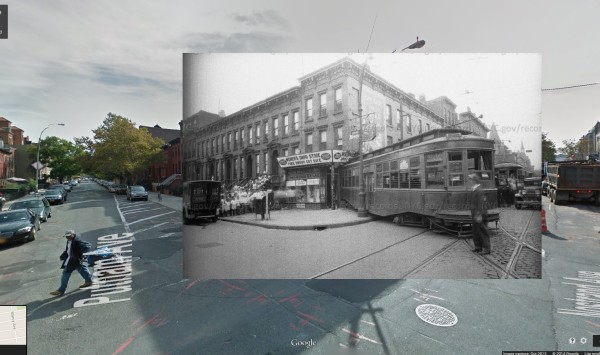
******************************************************************************************************************************** Brownstone Detectives investigates the history of our clients’ homes. The story you are about to read was composed from research conducted in the course of one of those investigations. Do you know the history of YOUR house? ******************************************************************************************************************************** We’ve all heard the famous opening line to the joke. But this one really happened. Rather, the streetcar “rolled” into the business, but only after jumping its tracks. This incident took place on 7 July 1931, at the corner of Putnam and Nostrand avenues in the Bedford-Stuyvesant section of Brooklyn. Fortunately, no one was killed, although six people were injured. Unfortunately, though, streetcar accidents had become a common occurrence in the days after streetcars stopped using horses for propulsion. And this was all too evident in Brooklyn, for within the past week, alone, four other streetcar crashes had occurred, injuring a total of 31 people. As a matter of fact, this was the final straw for Brooklyn’s D.A., who ordered an investigation into the “six B.M.T. trolley car accidents in the past few weeks.” His intention was “to determine whether or not there is cause for criminal proceedings.” It would have been understandable among many Brooklynites of the period if there were talk about returning the streetcar to the horse. For another story we’ve written about streetcars jumping their tracks, click HERE. Follow @BrownstoneDetec Share ———————————————————————————————————————– The Brownstone Detectives Brownstone Detectives is an historic property research agency. Our mission is to document and save the histories of our clients’ homes. From […]
THE DAY RIOTERS STORMED BROOKLYN (1895)
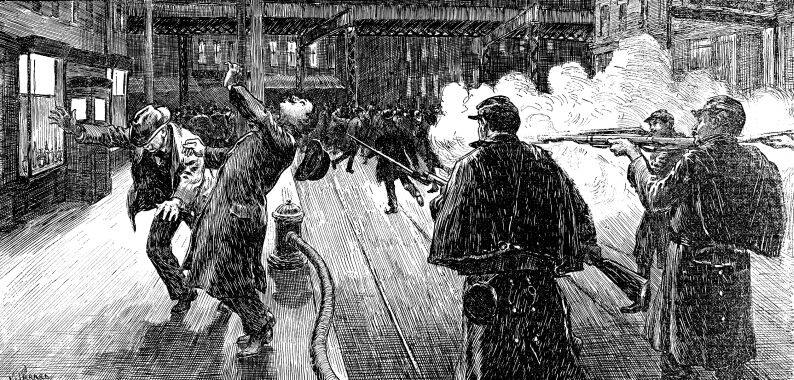
******************************************************************************************************************************** Brownstone Detectives investigates the history of our clients’ homes. The story you are about to read was composed from research conducted in the course of one of those investigations. Do you know the history of YOUR house? ******************************************************************************************************************************** (The above picture shows the New York State militia shooting a man on Halsey Street, near the corner of Broadway. You can see the recently erected elevated train line at the end of the block.) In 1895, Halsey Street near Saratoga Park had become a war zone. The Brooklyn Streetcar strike had begun on 15 January, and before the week was over the agitation would be in full force. The strike, which began with a walkout, would quickly devolve into a pitched battle between the Knights of Labor and streetcar workers on one side and the streetcar line owners, the police and the New York State Militia on the other. The main focus of much of the strikers’ attention in this part of Brooklyn, though, was the Halsey Street Rail Road Barns. These, located near the corner of Halsey Street and Broadway, were where the streetcar line stored its cars, quartered its horses, and from whence the line’s streetcars were dispatched. After the workers had called the strike, 5,500 of them would walk off the job for better conditions. The streetcar line owners (the lines were privately owned and operated at the time) countered this strike by calling in scabs who would attempt to operate the streetcars in the workers’ absence. […]
A STREETCAR JUMPS ON SACKETT STREET (1929)
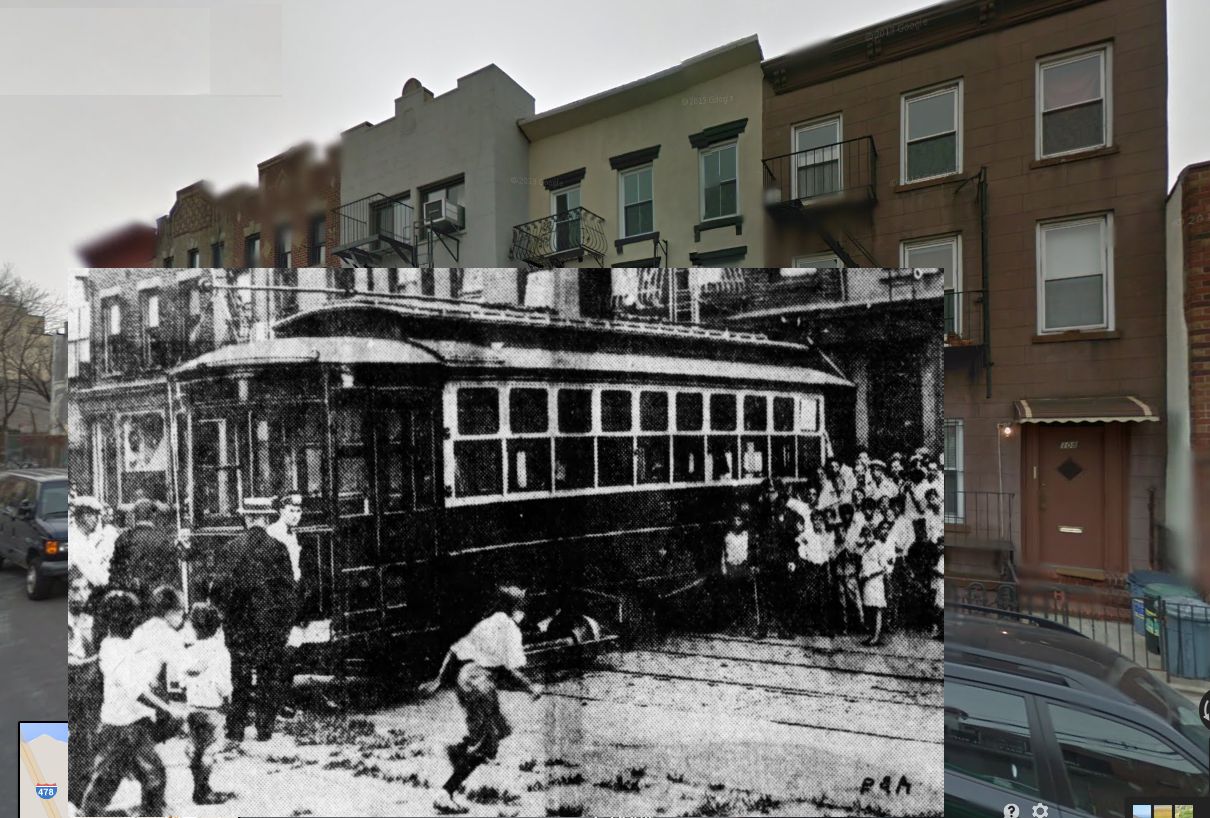
******************************************************************************************************************************** Brownstone Detectives investigates the history of our clients’ homes. The story you are about to read was composed from research conducted in the course of one of those investigations. Do you know the history of YOUR house? ******************************************************************************************************************************** If you bought a house that a streetcar had once crashed into – would you know about it? When researching the history of a client’s house, these are the stories that literally MAKE a House History Book. They are the stories that make the biggest splash – but in this case, a CRASH… But to the story… Back in the day, streetcars used to crash into buildings from time to time. The motormen’s reasons for this were usually that the car jumped the track while it was making a turn onto another street or avenue. In this instance, though, the motorman could only say that the streetcar “jumped,” but it does not appear that he was able to explain why – because he was operating the car in a straight line uphill on Sackett Street. While doing some research on a client’s home recently I saw this picture and I thought, “I didn’t even know that Sackett had a streetcar line!” Apparently, though, the line ran up and down the street back when it went both ways. The street must have been amazingly congested with these things going both ways! One day, in the Fall of 1929, though, that streetcar – starting on its run up the “slope” – literally “jumped” […]
ATLANTIC TERMINAL – 1910 vs. 2018
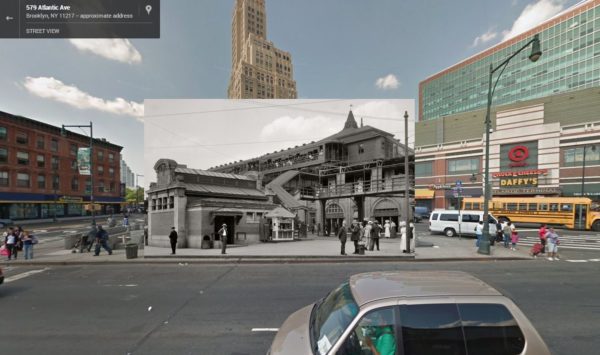
******************************************************************************************************************************** Brownstone Detectives investigates the history of our clients’ homes. The story you are about to read was composed from research conducted in the course of one of those investigations. Do you know the history of YOUR house? ******************************************************************************************************************************** We found a photograph taken at the “Atlantic Avenue subway entrance,” circa. 1910, and superimposed it onto an image taken from the same location, circa. today (courtesy Google Maps). The old picture shows an elevated railway and streetcar tracks in the background – the elevated railway is now underground and the streetcar has been replaced by city busses. If you look closely at the train cars, you can see that they are open on the sides, showing the time of year the photograph was taken. Also telling of the period (and the time of the year) are the boaters that the men are wearing – they were en vogue in mean’s spring/summer fashion at the time. There are also a couple of policemen, looking very much like London “bobbies” or “Keystone Cops” with their distinctive helmets. Notice anything else? Follow @BrownstoneDetec Share ———————————————————————————————————————– The Brownstone Detectives Brownstone Detectives is an historic property research agency. Our mission is to document and save the histories of our clients’ homes. From our research, we produce our celebrated House History Books and House History Reports. Contact us today to begin discovering the history of your home.
THE TRAIN THAT RAN ABOVE LEXINGTON (1947)
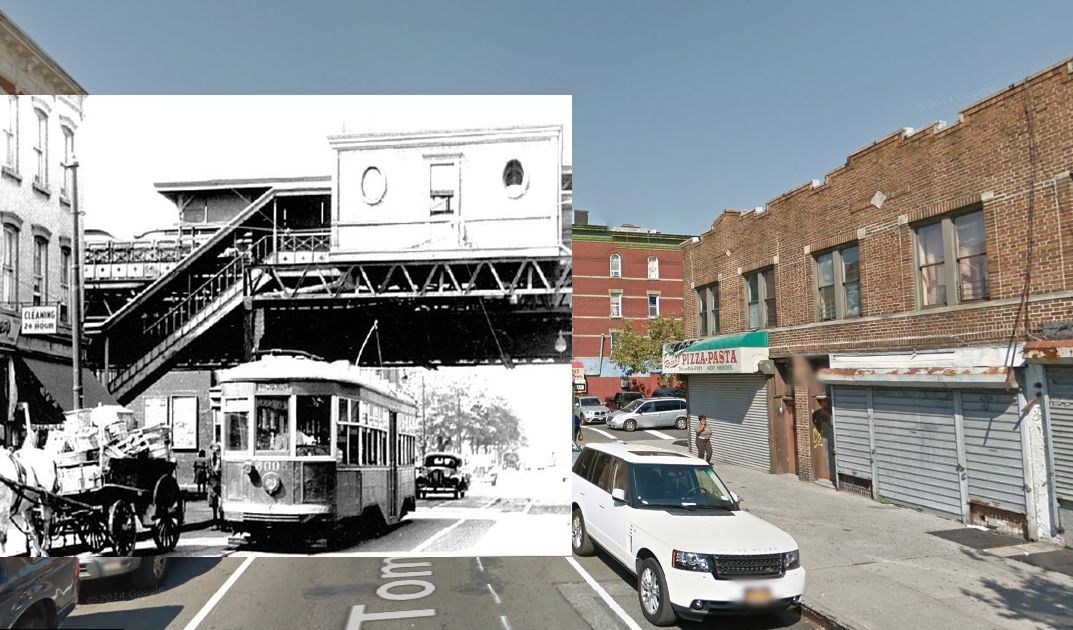
******************************************************************************************************************************** Brownstone Detectives investigates the history of our clients’ homes. The story you are about to read was composed from research conducted in the course of one of those investigations. Do you know the history of YOUR house? ******************************************************************************************************************************** Yes, there not only used to be a streetcar running down Tompkins Avenue in Bedford-Stuyvesant, but Lexington also at one time had sported its very own elevated subway train. Opening in 1885, the Lexington elevated train was in the vanguard of bringing owners and potential homebuyers to the Bedford and Stuyvesant Heights areas. The Lexington Avenue “el,” as it was called, split from the Myrtle Avenue elevated (yes, there was one up there, too) at Grand Avenue, where it headed down to Lexington then turned east and headed in the direction of Broadway. Taken in 1947, this picture shows the confluence of these two avenues and forms of transportation. You can also see automobiles of the period and an anachronism – even for the times – a horse with its cart parked along Tompkins. A few years after this picture was taken, demolition began on the elevated line. Read more about this line (and how long traces of it existed even after it had been demolished) on Forgotten New York. Follow @BrownstoneDetec Share ———————————————————————————————————————– The Brownstone Detectives Brownstone Detectives is an historic property research agency. Our mission is to document and save the histories of our clients’ homes. From our research, we produce our celebrated House History Books and House History […]
A BEER CALLED MÜNCH (1904)
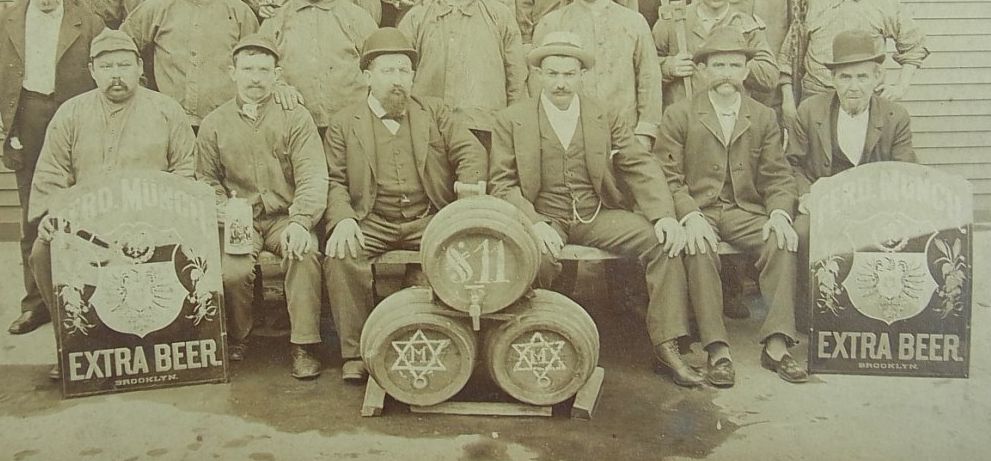
******************************************************************************************************************************** Brownstone Detectives investigates the history of our clients’ homes. The story you are about to read was composed from research conducted in the course of one of those investigations. Do you know the history of YOUR house? ******************************************************************************************************************************** One might wonder if a beer called “Münch” had at one time been on the receiving end of an unfortunate and slightly counter-intuitive moniker. Today, product names are usually selected based upon their abilities to stir some positive emotions – within the minds of the consumers – about their products. “Munch,” though, was not always an informal term describing a way of eating. More than 100 years ago, it was also a German name that was connected in the minds of many Brooklynites with a very satisfying “table beer.” THE MUNCH BREWERY The Ferdinand Münch Brewery, located at 277-299 Vernon Avenue from the late-1870s through to about 1920, when Prohibition spelled its end, satisfied the palates of Brooklyn, as a “family” beer, for more than 40 years. Housed originally within a building of old stone construction, Ferdinand Münch replaced the brewery building with a structure of brownstone and brick shortly after he purchased the property. Münch, though, would pass within the decade and leave his brewery to his sons, one of whom was William Münch. WILLIAM MUNCH AND HIS BROADWAY BUILDING In 1904, Sigmund Eisenbach, of 227 Gates Avenue, built a 4-story office building on the corner of Myrtle and Broadway, selling it to Ferdinand’s eldest son, William Münch, who had […]
BUTCHER, BAKER, UNDERTAKER (1895)
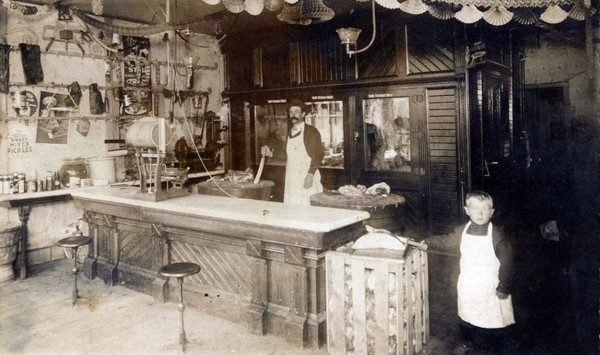
******************************************************************************************************************************** Brownstone Detectives investigates the history of our clients’ homes. The story you are about to read was composed from research conducted in the course of one of those investigations. Do you know the history of YOUR house? ******************************************************************************************************************************** As the sleeping giant that is Bedford-Stuyvesant’s Ralph Avenue begins to awaken from its slumber, it is tempting to take a look back at some of the businesses that once lined this bustling thoroughfare. STUYVESANT EAST OF YORE The eastern section of Stuyvesant was alive with industry in the late part of the 19th and the early part of the 20th centuries. As houses had recently been built along the main streets, stores, schools, and churches had gone up along the avenues and on corners, dotting the landscape with their offerings. The neighborhood, after its initial build-up in the 1890s, became completely self-sufficient in terms of goods and services. Residents of Macon Street, like those from the other streets in the neighborhood, found themselves surrounded by a variety of offerings that would allow them – and their servants, in some cases – to satisfy the needs of their families easily and quickly. THE BUSTLING BUSINESS CORRIDOR THAT WAS RALPH AVENUE Starting in the late 19th century, Ralph Avenue became a busy local business corridor filled with a wide variety of shops and stores that suburban families needed to support households of consumers. Since its inception, the avenue had public transportation, in the way of horse-drawn omnibuses and then later a streetcar […]
TIMEWARP TUESDAY! FULTON ST. FERRY TERMINAL (1900 v. 2014)
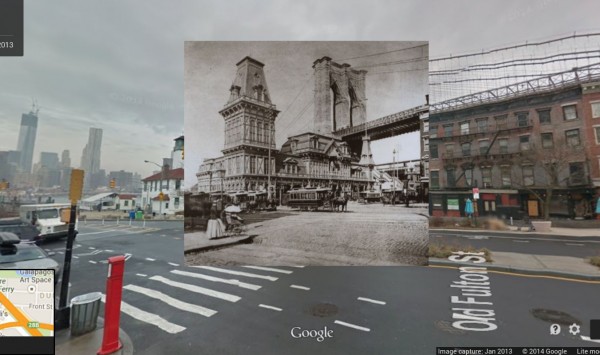
“Fulton Street, north side, at Water Street, showing the old Fulton Street Ferry Terminal and the Brooklyn Bridge tower. This is also a street car line terminal.” So reads the back of this ca. 1900 photograph. At that time, the ferries would land at the foot of Fulton Street and the streetcars – then horse-drawn – would take passengers to various parts of the borough. Here is a picture of this spot today: And the picture from 1900: Follow @BrownstoneDetec ———————————————————————————————————————– The Brownstone Detectives This story was composed from research performed by The Brownstone Detectives. Let us do an in-depth investigation of your house and its former owners and produce your very own House History Book. Your hardbound coffee table book will include an illustrated and colorful narrative timeline that will bring the history of your house to life. Contact us today.